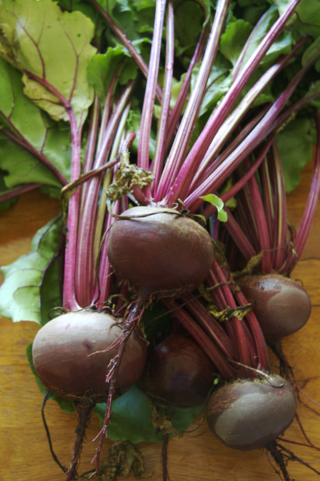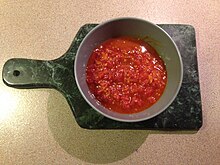
Hominy is a food item produced from dried maize (corn) kernels that have been treated with an alkali, in a process called nixtamalization. "Lye hominy" is a type of hominy made with lye.

Spaghetti is a long, thin, solid, cylindrical pasta. It is a staple food of traditional Italian cuisine. Like other pasta, spaghetti is made of milled wheat, water, and sometimes enriched with vitamins and minerals. Italian spaghetti is typically made from durum-wheat semolina. Usually the pasta is white because refined flour is used, but whole wheat flour may be added. Spaghettoni is a thicker form of spaghetti, while spaghettini is a thinner form. Capellini is a very thin spaghetti, while vermicelli refers to intermediate thicknesses.

An omelette is a dish made from eggs, fried with butter or oil in a frying pan. It is a common practice for an omelette to include fillings such as chives, vegetables, mushrooms, meat, cheese, onions or some combination of the above. Whole eggs or egg whites are often beaten with a small amount of milk, cream, or water.

Tripe is a type of edible lining from the stomachs of various farm animals. Most tripe is from cattle, pigs and sheep.

Tahini or tahina is a Middle-Eastern condiment made from ground sesame. Its more commonly eaten variety comes from hulled sesame, but unhulled seeds can also be used for preparing it. The latter variety has been described as slightly bitter, but more nutritious. It is served by itself or as a major ingredient in hummus, baba ghanoush, and halva.

The beetroot or beet is the taproot portion of a Beta vulgaris subsp. vulgaris plant in the Conditiva Group. The plant is also known as the table beet, garden beet, red beet, dinner beet or golden beet. Beetroot can be eaten raw, roasted, or boiled. Beetroot can also be canned, either whole or cut up, and often are pickled, spiced, or served in a sweet-and-sour sauce.

The zucchini, courgette or baby marrow is a summer squash, a vining herbaceous plant whose fruit are harvested when their immature seeds and epicarp (rind) are still soft and edible. It is closely related, but not identical, to the marrow; its fruit may be called marrow when mature.

The asparagus bean is a legume cultivated for its edible green pods containing immature seeds, like the green bean. It is also known as: yardlong bean, pea bean, long-podded cowpea, Chinese long bean, snake bean, bodi, and bora. Despite the common name of "yardlong", the pods are actually only about half a yard long, so the subspecies name sesquipedalis is a more accurate approximation.

Prune juice is a fruit juice derived from prunes that have been rehydrated. It is a mass-produced product that is often produced using a hot extraction method, and juice concentrate is typically produced using a low-temperature extraction method. It may be used as a dietary supplement to act as a laxative. It is also sometimes used as a flavor enhancer in tobacco products. It is an ingredient in many cocktails, such as the Purple Dragon, or Constipolitan.
Peasemeal is a flour produced from yellow field peas that have been roasted. The roasting enables greater access to protein and starch, thus increasing nutritive value. Traditionally the peas would be ground three times using water-powered stone mills. The color of the flour is brownish yellow due to the caramelization achieved during roasting, while the texture ranges from fine to gritty. The uses of peasemeal are similar to maize meal in baking, porridge and quick breads. Peasemeal has had a long history in Great Britain and is still used in Scotland for dishes such as brose and bannocks. Brose is similar to farina in its consumption by the addition of boiling water or stock to the peasemeal then eaten immediately with butter, pepper, salt, sugar or raisins.

Split peas are an agricultural or culinary preparation consisting of the dried, peeled and split seeds of Pisum sativum, the pea.
Bukharan Jewish cuisine is the traditional cuisine originating from the Bukharian Jewish community of Central Asia, who now mostly reside in Israel, and the United States.

Freekeh or farik is a cereal food made from green durum wheat that is roasted and rubbed to create its flavour. It is an ancient dish derived from Levantine and North African cuisines, remaining popular in many countries of the eastern Mediterranean Basin, where durum wheat originated.

Fried potatoes are a dish or a component of other dishes essentially consisting of potatoes which have been fried or deep-fried in hot cooking oil often with the addition of salt and other seasonings. They are often served as a side dish.

Turkey meat, commonly referred to as just turkey, is the meat from turkeys, typically domesticated turkeys, but also wild turkeys. It is a popular poultry dish, especially in North America and the United Kingdom, where it is traditionally consumed as part of culturally significant events such as Thanksgiving and Christmas respectively, as well as in standard cuisine.

Sardines ("pilchards") are a nutrient-rich, small, oily fish widely consumed by humans and as forage fish by larger fish species, seabirds and marine mammals. Sardines are a source of omega-3 fatty acids. Sardines are often served in cans, but can also be eaten grilled, pickled, or smoked when fresh.

Naem is a pork sausage in Lao and Thai cuisine. It is a fermented food that has a sour flavor. It has a short shelf life, and is often eaten in raw form after the fermentation process has occurred. It is a popular Southeast Asian food, and different regions of Southeast Asia have various preferred flavors, including variations of sour and spicy. Naem is used as an ingredient in various dishes and is also served as a side dish.

Bulgur, or burghul, is a cracked wheat foodstuff found in South Asian cuisine and West Asian cuisine.
















